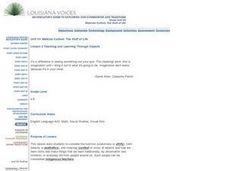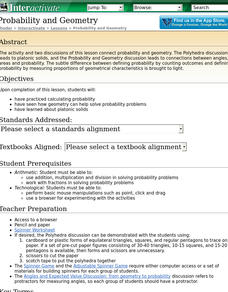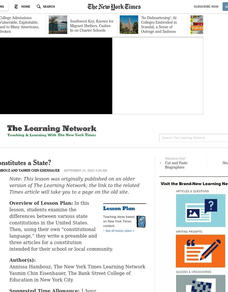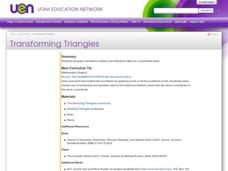Curated OER
Tall Tales
Students examine the characteristics of tall tales and how exaggerations are used. They create a character that is larger than life, they brainstorm attributes for their character, before writing a Tall Tale. They plan out their story,...
Curated OER
WHAT'S ORGANIC?
Students explore how certain foods come to be certified "organic." They write the words "organic" and "synthetic" and given the definitions of each. Students are given dictionaries. They are asked: "What is organic food?" Students grow...
Curated OER
Teaching and Learning Through Objects
Students identify and interpret the function, usefulness or utitlity, form, beauty or aesthetics, and meaning, context or story, of objects and how they learn new skills and make things that they learn traditionally, by observation and...
Curated OER
Extension Activities Mr. Popper's Penguins
Students read Mr. Popper's Penguins. In this Mr. Popper's Penguins lesson plan, students record descriptive clues from the book. Students research Adelie penguins and compare and contrast to their local community. Students...
Curated OER
Fighting for Fair Farming
Young scholars consider various economic terms, examine the impact of subsidies on farmers and other industries, write essays explaining the subsidy process, and illustrate through posters how subsidies affect both domestic and foreign...
Curated OER
The Buffalo War: A Clash of Cultures
Students view a documentary on the different values and meaning placed on the buffalo. Examining various cultures, they link the attitudes to the treatment of the animal in the wild. They develop solutions to the conflict raised by the...
Curated OER
The Chocolate Touch
Students read a book. In this story elements lesson, students share their favorite food, predict what the story will be about and discuss how they would feel if they got to eat their favorite food everyday. Students read the...
Curated OER
Revolutionary War Spy Methods
Young scholars research how coded messages were used during the Revolutionary War. In this Revolutionary War lesson, students view primary documents about the Revolutionary War spies and the methods used for sending messages. Young...
Curated OER
Mathematics Alive: Environment and Design of Human Habitats
Third graders explore the structural composition of buildings and houses. In this math lesson, 3rd graders explain how architecture is related to mathematics. They create a blueprint of a structure with at least three different spaces.
Curated OER
What Do Halloween Costumes Say?
Students analyze Halloween costumes they find in magazines to categorize their findings. In this holiday lesson, students discuss their findings about the costumes based on four different elements.
Curated OER
Probability and Geometry
Students practice calculating probability, see how geometry can help solve probability problems and explore platonic solids.
Curated OER
Oh, Let the Rain Fall Down
Fifth graders explain the three phases of the water cycle in a narraive paragraph where they describe the journey of a single raindrop. They are introduced to five science vocabulary words and personfication.
Curated OER
Storytelling in the Oral Tradition
Seventh graders research Greek mythological characters. They write about problems faced by middle school-aged children and how the character would handle them. Students also create story boards to accompany their oral narratives.
Curated OER
Donde en el mundo estas?
Learners give & follow directions given in Spanish, using oral, written and graphics. They use maps, globes, atlases, and remote sensing, GIS, and GPS to acquire and process information about places.
Curated OER
WHALES: GIANTS OF THE DEEP
Students study humpback whale migrations, feeding, social organization, population, scientific investigations and compare humpback whales , research to explore a specific type of whale, and create their own replica of a whale.
Curated OER
Rape: Psychology, Prevention and Impact
Learners are introduced to the characteristics of rape. As a class, they identify statements as either facts or myths about rape. In groups, they complete a survey to identify their own perceptions about rape and compare them with...
Curated OER
Computers: Caught in the Web
Young scholars conduct Internet research about various websites noting the design and appearance of them. Working in small groups, they compare and contrast the sites and share their opinions of them with classmates. They also examine...
Curated OER
Comparing Utah's Past and Present Government
Fourth graders research the past and present forms of government in Utah. In this government studies lesson students analyzes different forms of government and work with a group to gather information about how Utah was/is run and then...
Curated OER
Catherine, Called Birdy: April and May
Students create an etiquette book for women of Medieval times. In this Catherine, Called Birdy instructional activity, students discuss the setting and work in small groups to list things expected of women in the 1200s. ...
Curated OER
Where your food comes from
Students research where their favorite ingredients come from. In this ingredients lesson plan, students pick 2 ingredients and use the Internet to research where those ingredients originated from. Students then record their findings in a...
Curated OER
What Constitutes a State?
Students examine the differences between various state constitutions in the United States. Then, using their own
Curated OER
Sensitive Taste Test
Fifth graders investigate concentrated and diluted solutions by conducting a taste test. In this dilution lesson, 5th graders examine the concentration of different juices samples by tasting them and recording their observations....
Curated OER
Transforming Triangles
Sixth graders graph translations (slides) and reflections (flips) on a coordinate plane. They visualize and identify geometric shapes after applying transformations on a coordinate plane. Finally, 6th graders write a paragraph telling...
Curated OER
Plodding and Breaking Through:Walking and Carrying
Young scholars analyze and describe the contributions of various dance artists, performers, teachers, and choreographers. In this dance instructional activity, students fill in any gaps of knowledge they have in regards to dance training...























